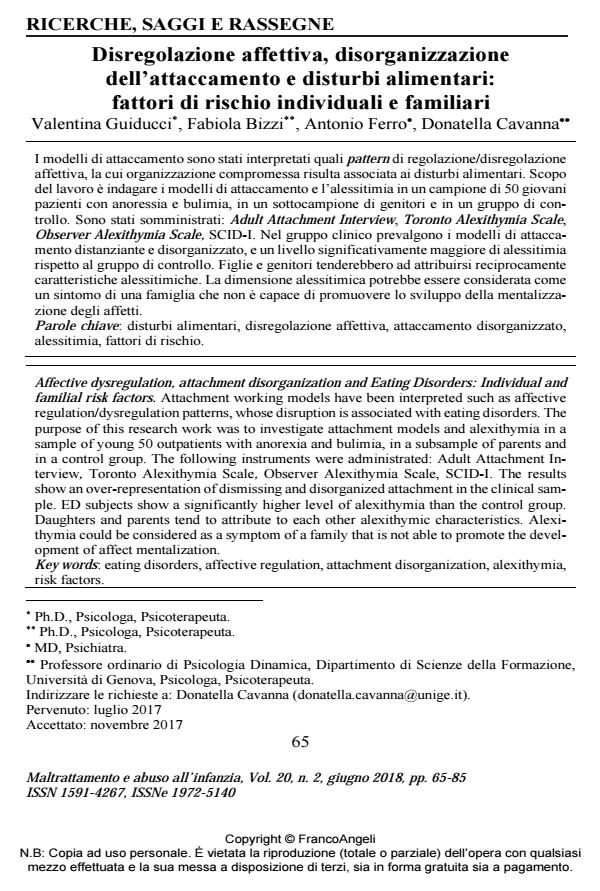Affective dysregulation, attachment disorganization and Eating Disorders: Individual and familial risk factors
Journal title MALTRATTAMENTO E ABUSO ALL’INFANZIA
Author/s Valentina Guiducci, Fabiola Bizzi, Antonio Ferro, Donatella Cavanna
Publishing Year 2018 Issue 2018/2
Language Italian Pages 21 P. 65-85 File size 228 KB
DOI 10.3280/MAL2018-002005
DOI is like a bar code for intellectual property: to have more infomation
click here
Below, you can see the article first page
If you want to buy this article in PDF format, you can do it, following the instructions to buy download credits

FrancoAngeli is member of Publishers International Linking Association, Inc (PILA), a not-for-profit association which run the CrossRef service enabling links to and from online scholarly content.
Attachment working models have been interpreted such as affective regulation/dysregulation patterns, whose disruption is associated with eating disorders. The purpose of this research work was to investigate attachment models and alexithymia in a sample of young 50 outpatients with anorexia and bulimia, in a subsample of parents and in a control group. The following instruments were administrated: Adult Attachment Interview, Toronto Alexithymia Scale, Observer Alexithymia Scale, SCID-I. The results show an over-representation of dismissing and disorganized attachment in the clinical sample. ED subjects show a significantly higher level of alexithymia than the control group. Daughters and parents tend to attribute to each other alexithymic characteristics. Alexithymia could be considered as a symptom of a family that is not able to promote the development of affect mentalization.
Keywords: Eating disorders, affective regulation, attachment disorganization, alexithymia, risk factors.
- Eating Disorders Cecilia Serena Pace, Stefania Muzi, Wanda Morganti, pp.1 (ISBN:978-3-030-67929-3)
- Parental attachment and cyberbullying victims: the mediation effect of gelotophobia Carla Canestrari, Gonzalo Del Moral Arroyo, Angelo Carrieri, Morena Muzi, Alessandra Fermani, in Current Psychology /2023 pp.16401
DOI: 10.1007/s12144-021-01642-6 - Eating Disorders Cecilia Serena Pace, Stefania Muzi, Wanda Morganti, pp.313 (ISBN:978-3-031-16690-7)
- Investigating Functioning Profile of Adolescents with Anorexia before and during the COVID-19 Pandemic: A Cross-Sectional Study on Mentalizing, Alexithymia, and Impulsiveness Fabiola Bizzi, Anna Riva, Simone Charpentier Mora, Marta Tironi, Sofia Elena Sforza, Lorenzo Maria Milani, Renata Nacinovich, in International Journal of Environmental Research and Public Health /2023 pp.3670
DOI: 10.3390/ijerph20043670
Valentina Guiducci, Fabiola Bizzi, Antonio Ferro, Donatella Cavanna, Disregolazione affettiva, disorganizzazione dell’attaccamento e disturbi alimentari: fattori di rischio individuali e familiari in "MALTRATTAMENTO E ABUSO ALL’INFANZIA" 2/2018, pp 65-85, DOI: 10.3280/MAL2018-002005